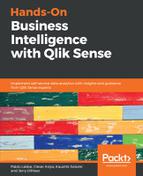Book Description
Create dynamic dashboards to bring interactive data visualization to your enterprise using Qlik Sense
Key Features
- Implement various Qlik Sense features to create interactive dashboards
- Analyze data easily and make business decisions faster using Qlik Sense
- Perform self-service data analytics and geospatial analytics using an example-based approach
Book Description
Qlik Sense allows you to explore simple-to-complex data to reveal hidden insights and data relationships to make business-driven decisions.
Hands-On Business Intelligence with Qlik Sense begins by helping you get to grips with underlying Qlik concepts and gives you an overview of all Qlik Sense's features. You will learn advanced modeling techniques and learn how to analyze the data loaded using a variety of visualization objects. You'll also be trained on how to share apps through Qlik Sense Enterprise and Qlik Sense Cloud and how to perform aggregation with AGGR. As you progress through the chapters, you'll explore the stories feature to create data-driven presentations and update an existing story. This book will guide you through the GeoAnalytics feature with the geo-mapping object and GeoAnalytics connector. Furthermore, you'll learn about the self-service analytics features and perform data forecasting using advanced analytics. Lastly, you'll deploy Qlik Sense apps for mobile and tablet.
By the end of this book, you will be well-equipped to run successful business intelligence applications using Qlik Sense's functionality, data modeling techniques, and visualization best practices.
What you will learn
- Discover how to load, reshape, and model data for analysis
- Apply data visualization practices to create stunning dashboards
- Make use of Python and R for advanced analytics
- Perform geo-analysis to create visualizations using native objects
- Learn how to work with AGGR and data stories
Who this book is for
If you're a data analyst, BI developer, or interested in business intelligence and want to gain practical experience of working on Qlik Sense, this book is for you. You'll also find it useful if you want to explore Qlik Sense's next-generation applications for self-service business intelligence. No prior experience of working with Qlik Sense is required.
